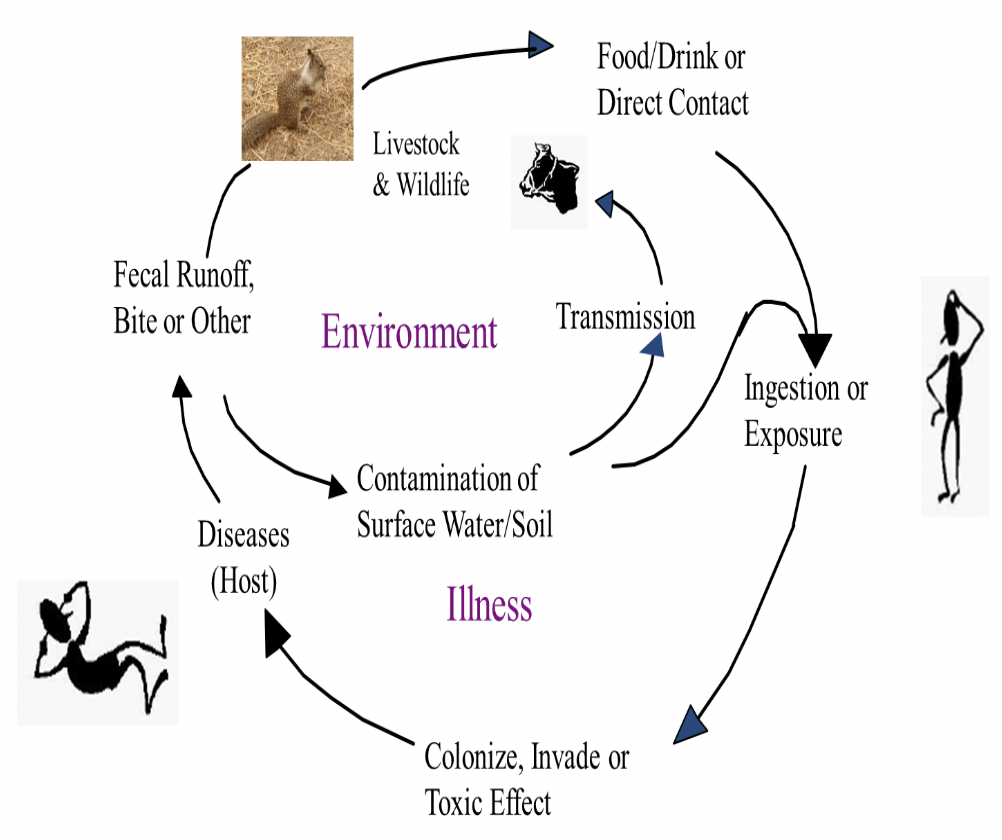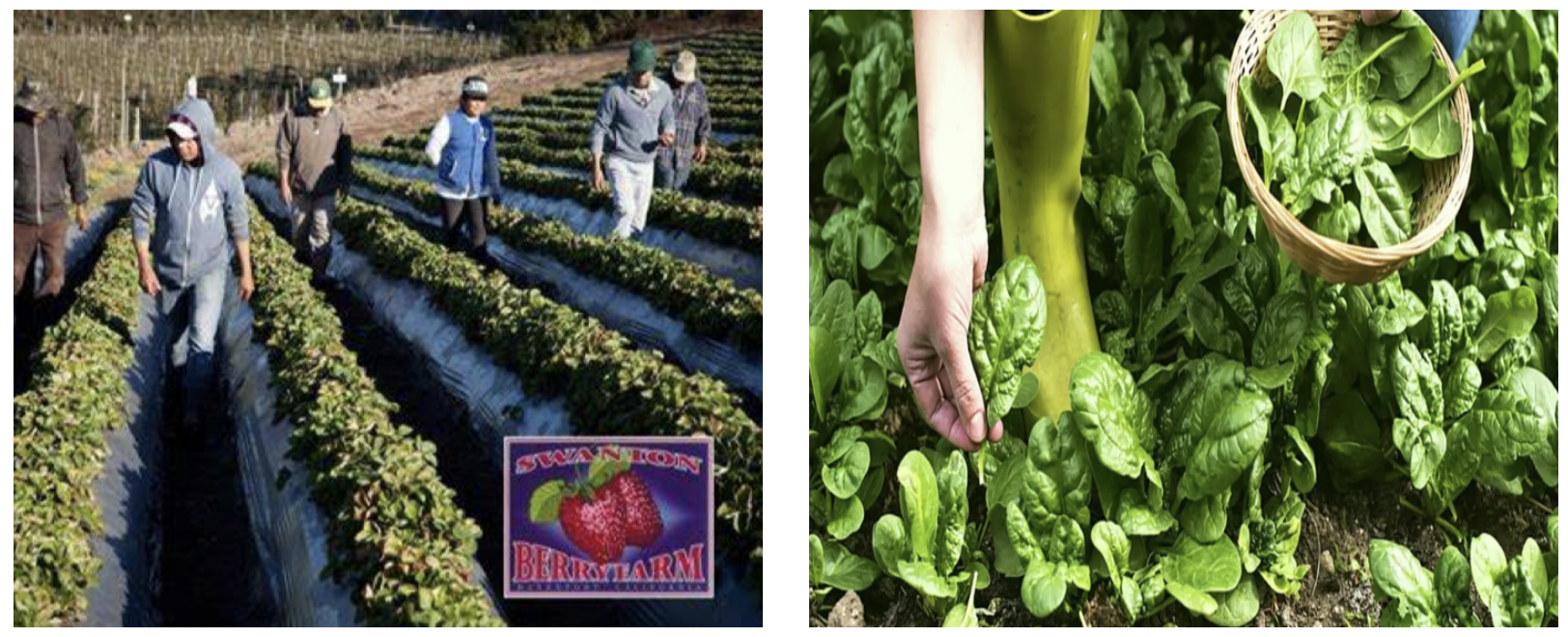Presentation
The Major Risk Factors at the Preharvest Level
There are three identified factors that can compromise food safety.
- Farm animals in backyard farm (BF) and integrated crop-livestock farm (ICLF) are a food safety risk
- Workers/visitors are a food safety risk as well as a risk to themselves
- Farm environment, specifically manure, and compost are a food safety risk
Farm Animals as a Food Safety Risk
Animals including livestock, pets, wild animals, birds, pest and rodents carry variety of human pathogens.

These pathogens can spread to humans and the environment, and then from the environment to humans through food and water. Many pathogens can colonize animal gut and increase their number. The resulting infected animal feces poses an issue by increasing the spread of zoonotic pathogens.
Recommendation for reducing farm animal-based risks
- Consider proximity (location/position) of animals to produce fields, water sources and flood areas
- Position crop areas appropriately, with barriers in place if they are near animals or areas at risk of runoff by considering nearby manure drops, manure lagoons or compost piles, neighbors’ activity (farms and residences), etc.
-
Add barriers either:
- Passive barriers: vegetative strips, fences, uphill, keep compost covered
- Active barriers: plant less-risky crops; have workers “wash out” between working with animals/produce; if possible work with produce first, then animals
- Discourage wildlife/animals from entering production areas by fencing, animal training, visual deterrents, sonic canons, animal relocation, discouraging areas to roost or nest, maintaining buildings in good conditions, keeping up with pest control programs
-
Anyone working with the animals should understand risks and be
trained to minimize risks, particularly:
- Workers’ activity manual should outline procedures for different activities that are found in the field
- Employ “no harvest buffer zones” around sites of significant animal intrusion
- Radius around intrusion is determined by feces frequency, trampling, splatter from rain or irrigation
- Cull produce, flag, bury, or remove feces from field depending on harvest dates and repicking, clean hands and tools
- Consider keeping a wildlife monitoring log
Workers/visitors as a food safety risk
Workers/visitors may carry human pathogens, such as Shigella, Hepatitis A, Norovirus, Cyclospora and others, as a carrier or asymptotically infected and/or mild sickness. These persons can spread pathogens to animal/plant as well as environment. Workers/visitors who are working with multiple farm components, can transfer pathogens (Salmonella and E. coli) from one component to others such as animals and plant/produce. Improper/unhygienic toilets or bathrooms enable workers to spread pathogens through the fecal-oral route, illness, and injury. Workers/visitors are often the last to touch produce before it reaches the consumer through clothing, footwear, or personal tools.

Recommendation to reduce risk due to visitors/malpractice of workers
- Good worker trainings including hand washing, cleaning and sanitization, reporting illness and compensation significantly reduce the risks of incidents and create health working environment
- Provide appropriate water for drinking, break areas for eating, stocked facilities that are regularly maintained, signage to enforce good hygiene practices and making available first aid kits
- Have SOP (Standard Operating Procedures) plans in place for injured person specifically recommendation for 1) cleaning, bandaging, and using glove over Band-Aid, 2) discard contaminated produce, 3) clean and sanitize tools, 4) prevent/compensate working with sickness (nausea, diarrhea, fever)
- Provide handwashing-training at the beginning , proper paper towels and soap
-
Handwashing signs focus on:
- Wash both front and backs of hands, wrists, as well as in between the fingers and rub 20 sec or more
- Rinse hands thoroughly with clean water
- Dry with a paper towel
- Turn off faucet with used towel
- Throw the paper towel in a trash can
Environment as a food safety risk
Manure or animal waste particularly feces are a great source of nutrients and the best way of recycle waste and soil amendment, but the whole process possesses a risk of:
- Soil and/water contamination through runoff
-
Contamination of:
- Plants, particularly produce grown on the soil amended with incomplete compost
- Grasses and grazing animals
- Surrounding wild animal, subsequently animal food products
- Other environmental factors such as infiltration of wild animals, birds, pest and rodents also possess risks of cross-contamination of food products and the spread of animal/zoonotic diseases

Recommendation to reduce environment-based risks
-
Proximity: If you have animals on the farm, consider
their proximity to produce fields and water sources:
- Position crop areas appropriately, with barriers in place if they are near animals or areas at risk of runoff and flooding by considering nearby manure drops, manure lagoons or compost piles, neighbors’ activity (farms and residences), etc.
-
Prevention: The following measures can be taken to
prevent cross-contaminate other farm components:
- Consider using specific clothing and boots to work with soil amendments
- Keep soil amendments covered – a bird dropping on compost makes it manure again
- Implement barriers to prevent runoff in produce area
- Put barriers either passive or active or both barriers such as vegetative strips and fence; keep compost and manure covered and plant less-risky crops uphill
- Have workers “wash out” between working with animals and produce; work with produce first, then animals, if possible
- Separate finished compost from un-finished and know manure treatment times and temperatures to make compost
- As pathogens can survive in untreated manure, the following time intervals must be maintained between manure application and harvest of contact produce (lettuce, carrots), 120 days, and non-contact produce (peppers, corn), 90 days
-
Training:
- Develop SOPs for animal and manure handling and finding feces in the field including hand washing, proper cleaning and sanitizing technique for equipment, changing clothes or shoes during moving to one component to other (plant to animal or animal to plant)
- Safe harvest training includes outlining procedures if significant activity is found in the field
- Cull produce, flag, bury, or remove feces from field depending on harvest dates and repicking, clean hands and tools
- Consider keeping a wildlife movement monitoring log
- Employ “no grown/harvest buffer zones” around sites of significant animal intrusion
- Provide information about animal specific pathogens, their transmission pathways and potential prevention
Final Safety Remarks
- Workers, farm livestock, and created waste materials including feces are potential sources/reservoirs of pathogens for either human, or animal or both and pathogens can spread from one farm component to another
- Vectors such as unexpected wild-animals, birds, rodents, and insects often also cross contaminate or introduce pathogens
- Considering the farm location and its animal/plant products, farmers or experts should develop a SOP and safety rules
- Training the workers and imposing the rules are the key to make safer products in ICLFs
Acknowledgements
This is the outcomes of a research project funded by USDA-NIFA (#20185110628809)